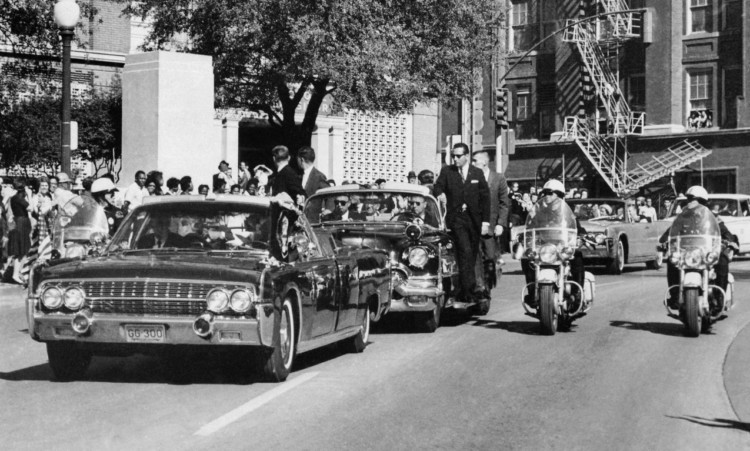Half a century ago today President John F Kennedy was assassinated in Dallas. Former Courier reporter Bryan Kay, now living in the American city, assesses the scene in the place where JFK met his end.
There’s something rather nondescript about the city of Dallas’s most famous landmark. After a recent tarting-up, its grassy knoll and white concrete pergolas have regained much of the pristine yet still very plain-Jane understated visage they bore when first opened to the public 73 years ago.
But, then, surely no one could ever have imagined when the city park known as Dealey Plaza was created in 1940 that it would become a world-renowned monument to the slaying of US President John F Kennedy just 23 years later.
The actual Dallas monument to JFK, erected in 1970, is sited a short distance away. Dealey Plaza bears the name of a one-time publisher of the city’s establishment newspaper, The Dallas Morning News, which, ironically, was a massive critic of Kennedy in the time leading up to his death on its doorstep.
But that was then. Over the years the plaza has become known only as the site of the 20th century’s most infamous murder mystery. As the place where a beloved head of state met his end, it now endures the strange status of equal part voyeuristic tourist draw and sacred ground.
Today it will fall silent to mark 50 years since President Kennedy was fatally shot there. There will be no room for the kind of conspiracy theory talk that rises out of its hubbub most other days of the year.
“This will be an event to rejoice in the remarkable life, legacy and leadership of John F Kennedy and to show that the city of Dallas remembers what a great loss it was for the entire world,” says a spokesman for the city’s ominously named 50th Committee.
Most of those normal days at the scene, there is a palpable sense of peace. Above the plaza, in the former Texas School Book Depository where Lee Harvey Oswald fired at the President’s motorcade, the Sixth Floor Museum tells the official story of JFK’s assassination.
But the plaza itself plays host to a small band of conspiracy theorists who peddle various alternative versions of who was behind the November 22 1963 assassination.
This year marks the first time Dallas has ever officially marked the anniversary of the president’s killing.
The city has always been a reluctant host to America’s most high-profile murder, mindful of the vilification pointed in its direction afterwards as it was branded a hotbed of right-wing hate.
Mayor Mike Rawlings has pledged to eschew the kind of murder voyeurism that so often envelopes the site.
Yet many visitors to the plaza do remain sceptical of the official version that Oswald acted alone. A majority of Americans albeit a receding one remain unconvinced of the lone gunman theory, according to recent polls.
“Over the years it just never felt right,” says one 55-year-old woman from Fort Worth, a neighbouring city of Dallas, who identifies herself only as Maureen. “I would be considered a conspiracy theorist, but I am a fact-seeker.”
She was speaking moments after listening to a presentation given by Mark A. Oates, a noted conspiracy theorist who postulates the presence of a second gunman behind the grassy knoll.
An opponent of Dallas’ policy of shutting out messages like his from the official proceedings, he says he won’t be present at the ceremony after refusing to apply for one of the 5,000 tickets made available to members of the public. “As long as you have a badge saying Lee Harvey Oswald did it, you’ll be more than welcome,” he says. “People like me are not.”
Still, amid the noise of conspiracy, there are those who quietly accept the official theory presented by the Warren Commission in 1964.
“It’s really simple: there was a guy sitting in a building who shot the president,” says Joe Elkington, a 28-year-old bartender from Duncanville, a suburb of Dallas. “I listen to both sides of the argument, their reasons, but I don’t believe the conspiracy theories.”
When the shutters go up for the Dallas ceremony, security will be tight. All those who received tickets first had to pass a police background check. The conspiracy theorists who did not receive a ticket will stage a commemoration of their own elsewhere in the Dallas downtown area. And the haphazardly-placed sticky tape on the road marking the spots of the two fatal shots that killed Kennedy will, for the duration of the ceremony at least, be gone.
City officials, meanwhile, say they are determined to make the event safe for participants and guests. The possibility of a terrorist attack or a smaller-scale disruption has weighed heavy on the minds of the authorities stage-managing proceedings.
Security was not so tight 50 years ago. We can only guess how both Dallas and world history might have looked today had it been otherwise.
